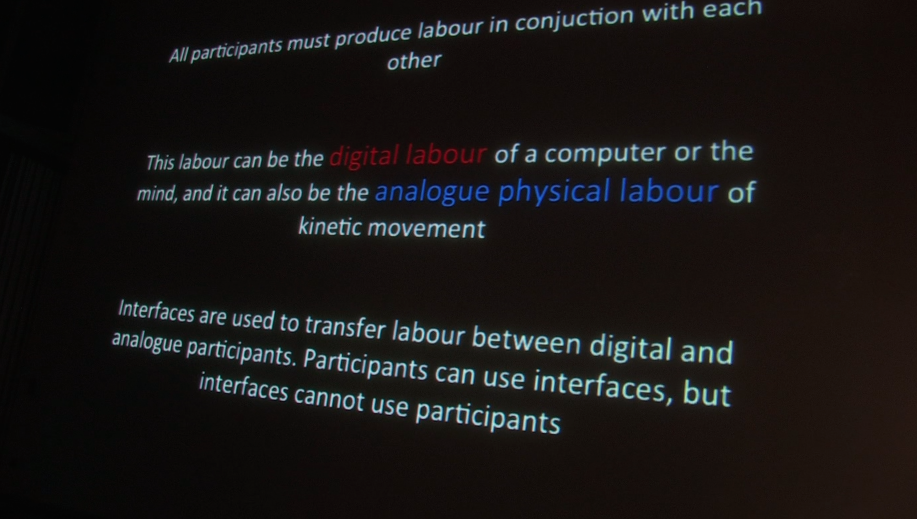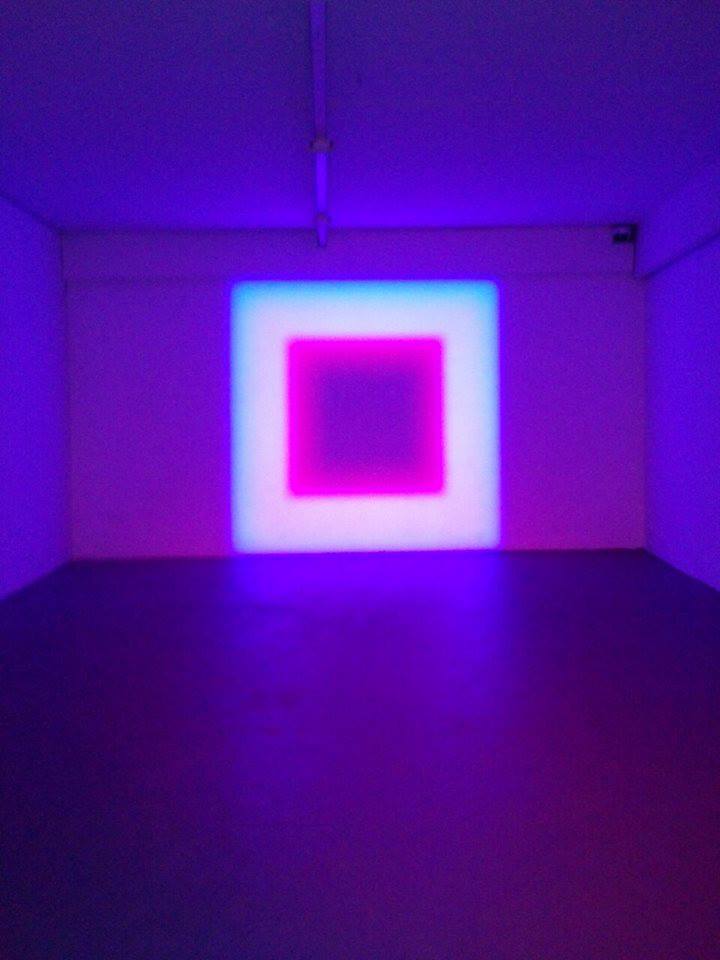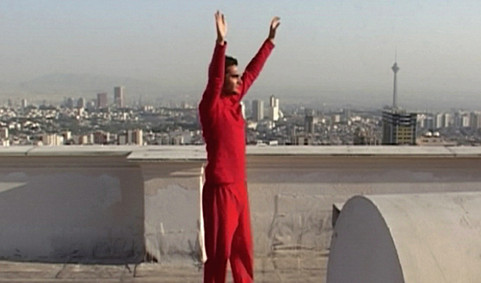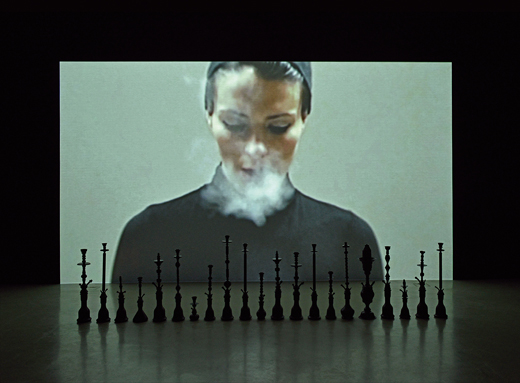
2013
no. 1 Notes on Autonomy and Hybrid Artistic Systems (Paulo Chagas)
no.2 Audible and Inaudible Choreography (Johannes Birringer)
no. 3
“The Sound of Movement Wearables”
(Johannes Birringer/Michèle Danjoux) Leonardo 46:3, pp. 233-40.
no. 4 Bauhaus, Constructivism, Performance (Johannes Birringer)
no.5 Information Consumerism The Price of Hypocrisy (Evgeny Morozov)
english version // german version
additional:
articles recommended by Vanessa Michielon:
John Toenjes, "Composing for Interactive Dance: Paradigms for Perception," in Sound Moves Conference 2005 – Proceedings, pp. 189-196.
Pieter Verstraete, "Interfacing Dance. Choreographing (by) gestural controls," in Sound Moves Conference 2005 – Proceedings, pp. 197-203.
Jamie Jewett, "REST/LESS: Performing Interactivity in Dance, Music and Text," in Sound Moves Conference 2005 – Proceedings, pp. 89 - 102.
Introduction to: Moving without a Body, new book by Stamatia Portanova

Excerpt from the new Manifesto on Interactive Art developed by the Interaktionslabor participants
Press Release for Interaktionslabor 2013 / Pressemitteilung zum 10. Interaktionslabor
download here (english) download here (deutsch)
Press preview: Saarbrücker Zeitung (3. August 2013)
Research Materials for the 2013 labortory:
Exhibitions
Saarländisches Künstlerhaus Saarbrücken
Ingo Bracke: "Hommage to The Cube, 13.2"

27.06.13 bis 18.08.13
Saarländisches Künstlerhaus
Karlstraße 1
66111 Saarbrücken
Telefon: 0049(0)681372485
www.kuenstlerhaus-saar.de
* * *
Stadtgallerie Saarbrücken
Anahita Razmi
„Swing State“
 .
.
Roof Piece Teheran (left), Arsenals (right)
20. Juni - 1. September 2013
http://www.stadtgalerie-saarbruecken.de/de/startseite
Die Stadtgalerie Saarbrücken präsentiert Anahita Razmis Werk erstmals in großem Umfang mit einem Schwerpunkt auf ihren jüngsten Foto- und Video-Produktionen: Im Januar 2013 realisierte die Künstlerin mit ihrer Performance "Re/Cut Piece" in Dubai ein Re-Enactment der legendären Performance "Cut Piece" von Yoko Ono (1964). Cut Piece war ein Entblößungs-prozess, der im unmittelbaren Austausch mit dem Publikum stattfand und die körperlichen Grenzen zwischen Betrachtern und Künstlerin, zwischen Angreifern und Opfer, und auch zwischen männlichem Zuschauer-Subjekt und der Frau als Objekt spürbar machte. Mit "Re/Cut Piece" transferierte Razmi die ursprüngliche Performance aus ihrem feministischen Kontext der 1960er Jahre in das zeitgenössische Dubai.
Bereits 2011 hatte Razmi die Performance "Roof Piece" (1973) der amerikanischen
Choreografin Trisha Brown zum Ausgangspunkt einer ähnlichen Überführung
gemacht. Während bei Brown die Dächer von Downtown Manhattan zur Bühne
improvisierter Tanzbewegungen wurden, nutzte Razmi die politische Bedeutung
der Dachlandschaft Teherans als Ort der Revolution (2009) für ihre Choreografie.
Aus Sicherheitsgründen war ihr "Roof Piece Tehran" jedoch nicht
wie Trisha Browns Stück als Live-Performance zu erleben, sondern gelangte
erst in dem Moment an die Öffentlichkeit, als die Künstlerin die zwölf
Videosequenzen des Stücks auf der Frieze Art Fair in London präsentierte.
^^^
The video installation "Arsenals"
consists of a video projection and a line of black water pipes. The video is
showing a portrait of the artist, who is blowing clouds of smoke into the camera
in an endless series. The video images, playing in slow motion, are accompanied
by strung together extracts of movie soundtrack compositions. The pieces of
music originate from a selection of catchy movie scenes: catastrophes, climaxes,
showdowns, moments of tension / suspense. The repetition of the minimal body
movement in combination with the loaded musical composition produces a minimal
but at the same time strongly stylized image, that is referring to popular cinematic
strategies and effects. The staged climax is replaced and covered by a smoke
screen, which is transforming the physical activity into a pathetic buzzword.
A number of black sprayed waterpipes is placed in front of the video projection.
Their original function is abstracted by color and array, within the installation
they might recall an arsenal of weapons.

Performed in January 2013 in Dubai, the work "Re/Cut Piece" is a re-enactment of Yoko Ono's seminal performance „Cut Piece“. In „Cut Piece“ Yoko Ono was sitting motionless on a stage, a pair of scissors next to her. Audience members were invited to come onto the stage and cut off pieces of Ono's clothing. The piece was first carried out in Japan in 1964, a performance in New York followed in 1965. "Re/Cut Piece" is taking Ono's performance out of its former context and original narrative to Dubai 2013, - exchanging Ono's rather insignificant performance dress to a luxury GUCCI dress. By re-focussing the performance on the value of the dress, new associations and meanings automatically invade the piece. The change of location to Dubai, -a city, often considered as a modern stereotype for splendid luxury living, prodigality, nouveau-riche, megalomania-, furthermore adds to the demand of a re-reading. What does the conjoint act of destructing a luxury dress mean in this location? An act of dissipation? An act of liberation? Considering the feminist aspect of Ono's work, can the piece find an update by relocating it to Dubai? Relating to these questions, „Re / Cut Piece“ is aiming to correspond with its performance location and work with its shifting image.
* * *
Berliner Kunstraum Tanas
"Agoraphobie“

Der Raum, in dem Protest möglich wird
* * *
Portikus, Frankfurt
Anne Imhof
"Parade"
13. Juli - 8. September 2013

Dies ist
die erste institutionelle Einzelausstellung der Künstlerin Anne Imhof..
Die Ausstellung ermöglicht einen umfassenden Einblick in Imhofs künstlerische
Herangehensweise und verdeutlicht die Vielschichtigkeit, die sie ihrer Arbeit
verleiht. Anknüpfend an die Geschichte der Performance im Bereich der Kunst
sowie in der Musik und Choreografie untersucht die Künstlerin überlieferte
Bilder, Strukturen und Abläufe und entwickelt neue Taktiken, um zu einem
erweiterten Performance-Begriff beizutragen. Zentral hierbei ist die Auseinandersetzung
mit der viel diskutierten und oft als problematisch empfundenen Dokumentation
von Performance. Die Ausstellung im Portikus zeigt, wie Imhof die Vergänglichkeit
der Performance – durch das Einführen von unterschiedlichen Medien
wie Film, Zeichnung und Installation – zeitlich und räumlich zu entzerren
vermag.
Die Filmaufnahmen, die im Hauptraum des Portikus zu sehen sind, zeigen drei
Performances der Künstlerin. Die Arbeit School of the Seven Bells
übersetzt Robert Bresson Film Pickpocket von 1959 in eine komplexe, über
Monate erarbeitete und einstudierte Choreografie, die den Tanz des Taschendiebstahls
porträtiert. Imhofs neuste Arbeit, Aqua Leo, 1st of at least
two, die speziell für die Ausstellung im Portikus entstanden ist,
nimmt Rituale und Geheimzeichen auf, die nachts an der Eingangstür zum
legendären Musikclub Robert-Johnson in Offenbach zwischen dem Türsteherpersonal
ausgetauscht werden. Die Künstlerin greift Insider-Codes auf, die auf ganz
bestimmte Zugehörigkeiten hinweisen, und stellt sie in neue Zusammenhänge.
Anne Imhofs
Arbeiten sind bereits in ihrer Entstehung in mehreren Versionen angelegt. Diese
entfalten sich über einen undefinierten Zeitraum und an unterschiedlichen
Orten. So führte sie 2010 die Performance Ähjeii als Beitrag
zum alljährlichen Städelschule-Rundgang auf, um die gleiche Arbeit
beim Rundgang ein Jahr später in einer weiterentwickelten Ausführung
erneut zu zeigen. 2012 inszenierte und filmte sie die Arbeit, um sie als Video
zu präsentieren und live den Sound dazu zu spielen. Für die Ausstellung
im Portikus griff Imhof Ähjeii erneut auf und filmte die Choreografie im
öffentlichen Raum, ohne Zuschauer. So imitiert sie die Dokumentation der
Performance im Vorfeld. Dies ist beispielhaft dafür, dass die Künstlerin
eine Strategie entwickelt hat, mit der sie das Medium Performance von seinem
klassischen Ablauf „Publikum—Event—Dokumentation“ ablöst.
Die gleiche Vorgehensweise wendet Anne Imhof auf die zwei weiteren im Portikus
präsentierten Arbeiten Aqua Leo, 1st of at least two und School
of the Seven Bells an. Zusammen mit Ähjeii finden sie während
der Laufzeit der Ausstellung in neuer Variation statt. Die zuvor filmisch aufgezeichneten
Bewegungen, Gesten, Zeichen und Blicke der Akteure – sogar die Akteure
selbst – werden deutlich wiedererkennbar sein. Das Interesse der Künstlerin
an der Hinterfragung des „wirklich Erlebten“ bekommt durch das Einsetzen
von Sound eine zusätzliche Ebene. Zusammen mit Billy Bultheel vom Institut
für Angewandte Theaterwissenschaft an der Universität Gießen
hat Imhof eine mehrteilige Komposition entwickelt, die im Ausstellungsraum zu
hören ist und bei den Performances von ihnen live gespielt wird. So entsteht
eine Sprache, die sich nicht über Worte, sondern über das Zusammenspiel
von Bild, Bewegung und Klang vermittelt.
Die Installation im Portikus beinhaltet darüber hinaus eine überdimensionale
Zeichnung, die in die Decke des Raums eingespannt ist. Hier erkennt man Skizzen
für Abläufe der Performances, Bewegungsmuster für die Akteure
sowie Linien für die Aufteilung der Gruppen. Um zu verdeutlichen, dass
der Prozess, also auch Zeichnungen und Dokumente, welche die Entwicklung von
Imhofs Arbeiten beschreiben, im komplexen Konstrukt des Werks Bedeutung hat,
zeigt der Portikus im Obergeschoss eine Auswahl an ihren Zeichnungen.
Am 7. September schließt die Ausstellung mit einem Konzert im Portikus
von Imhofs Band Beautiful Balance sowie einem Auftritt von DJ Chloé im
Club Robert Johnson.
Zur Ausstellung wird eine Publikation erscheinen. Zudem entwirft Anne Imhof
eine Künstleredition.
Anne Imhof wurde 1978 in Gießen geboren und lebt und arbeitet in Frankfurt
am Main. Sie ist Absolventin der Städelschule und wurde 2012 mit dem Absolventenpreis
ausgezeichnet. 2013 ist sie Stipendiatin der Hessischen Kulturstiftung.
* * *
Sound Art. Sound as a Medium of Art
ZKM Karlsruhe (Germany)
March 17th, 2012–January 06th, 2013
http://soundart.zkm.de/
http://soundart.zkm.de/en
The exhibition “Sound Art. Sound as a Medium of Art” presents for the first time the development of sound art in the 21th century at the ZKM | Media Museum and in a public space. From Futurism to Fluxus, through to Twitter sonifications, the ZKM charts the history of Sound Art during the 20th century. However, focus is placed on contemporary practices: with works from 90 artists from which approximately 30 new productions from recent years will be represented, the visitor gains insights into the unique sound cosmos of contemporary art. The sound world visualizes its own exhibition architecture, and the exhibition visitor himself becomes the generator of sounds.
Visual experience dominates in numerous exhibitions. “Sound Art. Sound
as a Medium of Art” emphasizes auditory experience and transforms the
visual experience. The visitor is thus provided with the opportunity to become
acquainted with an entirely new sound cosmos, which neither radio, film nor
the music industry has been able to establish to such an extent.
The Futurist painter and composer Luigi Russolo published the musical manifesto
“L’arte dei rumori” in 1913 elevating urban noises to the
level of an art. In the 1950s and 1960s representatives of musique concrète
and the artists of the Happening and Fluxus movement (from Yoko Ono through
to La Monte Young) extended the performative aspect of music; hence, in place
of composition there could be randomness, in place of music, silence, in place
of an orchestra, the sea and in place of the musician, a horse. In the 1970s
and 1980s Industrial Noise influenced even pop music, as well as punk music.
At the same time, loudspeakers became the building blocks of monumental sculptures,
light and sound were compressed into mobile immaterial environments, inaudible
realities were rendered audible in a synthesis of arts and hearing was gauged
again by means of psychoanalytical experiments. Sonifications of information
and medial communication, sound environments as well as telematic or medial
constellations exert an influence on the present-day multiplicity of creative
output. In this connection, those political questions in sound art that lead
to critical examination of sound and listening, occupy a central place.
The exhibition “Sound Art. Sound as a Medium of Art” makes new sound
perceptions not only experienceable in the museum: passers-by may encounter
sounds in the three installations located in the forecourt of the ZKM and five
installations in public areas around the city of Karlsruhe. In addition, a selected
concert program with outstanding performative projects enriches the exhibition:
LaMonte Young, Xenakis, Cage and Ryoji Ikeda are representative of the program’s
broad spectrum. The exhibition’s wealth of sounds has also been facilitated
by the richness of the archives made accessible to the Karlsruhe public for
the first time to this extent. Included are the “unheard avant-garde”
from Scandinavia, the Broken Music Archiv from Berlin and curated audiopoints
from european archive inventories.
Curator: Peter Weibel Co-Curator / Project coordinator: Julia Gerlach
New book publication
Tanz und WahnSinn / Dance and ChoreoMania

ed. Johannes Birringer & Josephine Fenger
Yearbook 21 of GTF, German Society for Dance Research.
August 2011 / Leipzig: Henschel Verlag, ISBN-10: 3894877103
In German and English. € 19,90
Throughout the history of civilization, dance and madness have been intricately
linked to each other – from the Dionysian Mysteries of antiquity
to contemporary flash mobs and techno raves. Individual and collective states
of exception have found expression and reflection as well as
cathartic healing through dancing. Tanz
und WahnSinn/Dance and ChoreoMania (online contents and illustrations) presents
a provocative collection of interdisciplinary studies
on dance and madness combining historical, cultural, schizoanalytic, medical,
philosophical, therapeutic and artistic perspectives
that explore the phenomenon.
+ + +
Texte und Kommentare zum Labor 2013 werden hier veröffentlicht
Texts and commentaries on the 2013 lab and related research subjects will be published here.